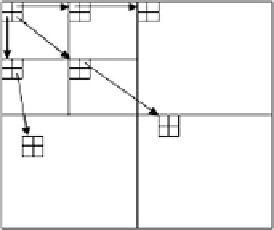Biomedical Engineering Reference
In-Depth Information
Fig. 4 Level wavelet
decomposition with spacial
orientation tree
In a wavelet-based still image, coding algorithm known as contexual set par-
titioning in hierarchical trees (CSPIHT) is developed that generates a continuously
scalable bit stream. This means that a single encoded bit stream can be used to
produce images at various bit-rates and quality, without any drop in compression.
The decoder simply stops decoding when a target rate or reconstruction quality has
been reached. In the CSPIHT algorithm, the image is first decomposed into a
number of subbands using hierarchical wavelet decomposition. The subbands
obtained for a two-level decomposition are shown in Fig.
4
.
The use of arithmetic coding only results in a slight improvement for a five-
level decomposition. The information that we know about the image file that is
produced from wavelet transformation is that it can be represented in a binary tree
format with the root of the tree having a much larger probably of containing a
greater pixel magnitude level than that of the branches of the root. The algorithm
that takes advantage of this information is the CSPIHT algorithm. The architecture
of CSPIHT is shown in Figs.
5
and
6
.
Proposed System
With the DICOM standard, it is easy to eliminate textual information such as
patient name and ID. The problem of text identification arises in many applications
other than medical security. However, the algorithms used in such systems are not
designed to handle superimposed text because it is difficult to differentiate the
edges of text from the edges of the medical objects in the image. We use
Daubechies' wavelets and analysis techniques to detect the high frequency vari-
ation in the diagonal direction that is indicative of text. With some basic knowl-
edge of the machine used to create the image, we are able to eliminate only
sensitive patient identification information while retaining the medical information
in the image. Excellent results have been obtained in experiments using a large set
of real-world medical images many with superimposed text (Fig.
7
).

Search WWH ::

Custom Search